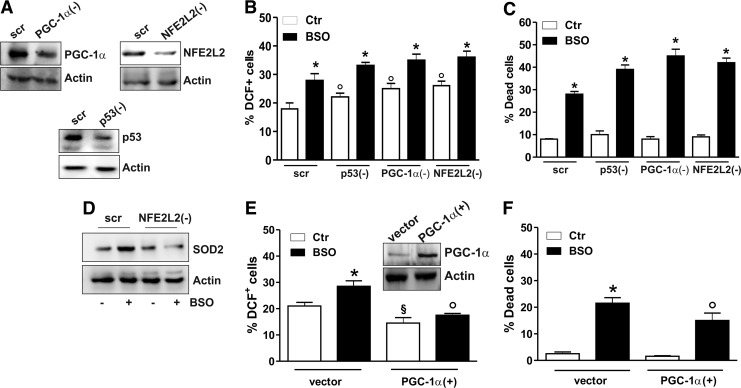FIG. 5.
PGC-1α prevents oxidative stress and cell death mediated by the loss of GSH. (A–C) SH-SY5Y cells were transfected with scramble (scr) or PGC-1α siRNA [PGC-1α(−)], p53 siRNA [p53(−)], or NFE2L2 siRNA [NFE2L2(−)] and treated with BSO for 15 h. (A) PGC-1α, p53, and NFE2L2 downregulation was detected by Western blot analysis. (B) Cells were treated with BSO for 15 h and assayed for ROS/ONOO− production by cytofluorimetric analysis after DCF-DA staining. ROS/ONOO− level was reported as percentage of DCF-positive cells and expressed as means±SD (n=4, *p<0.001 vs. BSO-untreated scr; °p<0.01 vs. BSO-treated and untreated scr). (C) Cells were treated with BSO for 48 h, and dead cells were counted by Trypan blue exclusion. Data are expressed as means±SD (n=5, *p<0.001 vs. BSO-untreated scr). (D) SH-SY5Y cells were transfected with scramble (scr) or NFE2L2 siRNA [NFE2L2(−)] and treated with BSO for 15 h. Cells were lysed, and 20 μg of proteins was used for Western blot analysis of SOD2. (E) SH-SY5Y cells were transfected with empty vector (vector) or with PGC-1α cDNA [PGC-1α(+)] and treated with BSO for 15 h. PGC-1α upregulation (inset) was detected by Western blot. Cells were assayed for ROS/ONOO− production by cytofluorimetric analysis after DCF-DA staining. ROS/ONOO− level was reported as percentage of DCF-positive cells and expressed as means±SD (n=4, *p<0.01 vs. vector-untreated cells; °p<0.001 vs. BSO-treated vector, §p<0.01 vs. BSO-untreated vector). (F) Cells were treated with BSO for 48 h, and dead cells were counted by Trypan blue exclusion. Data are expressed as means±SD (n=5, *p<0.001 vs. vector-untreated cells; °p<0.01 vs. BSO-treated vector). All the immunoblots reported are from one experiment representative of four that gave similar results. Actin was used as loading control. ROS, reactive oxygen species.

